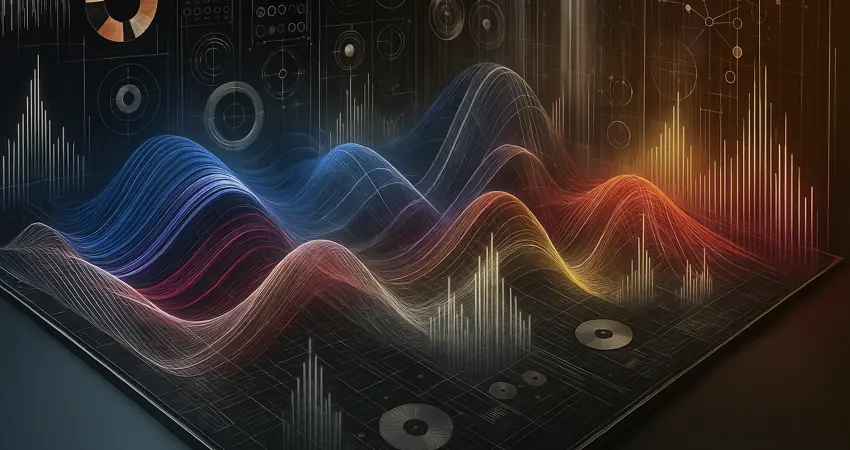08 Jul 2025
Outperforming State-of-the-Art 3D source localisation with entropy-based algorithms
Oxford research demonstrates that entropy-based algorithms can outperform leading 3D source localisation technology in assessing Alzheimer’s Disease, marking a significant step toward widely accessible early detection using brainwave data.

Researchers at Oxford’s Department of Engineering Science have demonstrated – for the first time – that entropy-based markers can outperform state-of-the-art algorithms for reconstructing 3D brainwave data. These markers are both more interpretable and quicker to compute. The findings, just published in NeuroImage, the world’s top-ranked neuroimaging journal, mark a significant step toward widely accessible early detection of brain disorders such as Alzheimer’s Disease.
Dr Wolfgang Frühwirt, lead researcher of the project and founder of object_a , explains how the work aligns with the broader mission of AI-in-the-loop systems: “We aim to help health practitioners make better, data-driven decisions by combining human expertise with advanced algorithms. This becomes critical when signals are weak or noisy, yet decisions carry significant real-world consequences, such as in the early detection of life-threatening diseases.”
Professor Stephen Roberts, says: “This research demonstrates how efficient algorithms can simultaneously enhance interpretability and accuracy. It underscores our belief that the most impactful solutions blend mathematical elegance and intuitive clarity.
Dr Frühwirt and Professor Roberts, leader of the Machine Learning Research Group at Oxford, have collaborated across various domains for nearly a decade, but they find their work addressing critical medical conditions especially rewarding.
Alzheimer’s disease – the most common form of dementia affecting over 55 million people worldwide – presents a major challenge for diagnosis and monitoring. Clinicians rely on biomarkers to track the progression of this neurodegenerative illness, but the available high-accuracy methods (like PET scans or spinal fluid analyses) are costly and invasive. Electroencephalography (EEG), which uses sensors on the scalp to measure brain waves, offers a non-invasive and widely accessible alternative for detecting Alzheimer’s-related brain changes. However, a key drawback of EEG is its low spatial resolution – it’s difficult to tell where in the brain signals originate from. To overcome this, clinicians and researchers often employ algorithms to map EEG signals into a 3D model of the brain. The big question: does this complex 3D reconstruction actually improve our ability to track Alzheimer’s disease severity?
The study detected statistically significant correlations between quantitative EEG measures and the clinical severity of Alzheimer’s disease: individuals with greater cognitive impairment displayed more pronounced EEG alterations. These findings support the view that quantitative EEG can capture effects of neurodegeneration.
“EEG is inexpensive and widely available, so demonstrating its strong correlation with Alzheimer’s severity is exciting – it means we have a practical window into the disease’s progression,” explains Professor Georg Dorffner from the Medical University of Vienna, a collaborator and senior author of the study.
However, the team was surprised to discover that 3D source localisation did not improve the results. The advanced 3D mapping yielded no better correlation with disease severity than the direct analysis of surface EEG data. In fact, the single best-performing marker in the entire study turned out to be a measure derived from the regular EEG signals.
This best-performing EEG marker – auto-mutual information (AMI) – is an entropy-based metric. In information theory, entropy quantifies uncertainty; when one compares a signal with a time-lagged copy of itself, the resulting AMI measures how much information the present still shares with the past. Healthy brain activity is rich and dynamically varied, so its self-predictability fades quickly, and AMI drops steeply as the lag increases. In Alzheimer’s disease, by contrast, cortical rhythms become slower and more stereotyped, making the signal more predictable; AMI therefore declines more slowly. This property makes AMI a sensitive, interpretable indicator of the loss of dynamical complexity that accompanies Alzheimer’s disease.
The team had expected the source imaging to give them an edge, but it turned out the most informative indicators were already present in the regular surface data. This finding suggests that, at least for Alzheimer’s disease, the extra complexity and computational cost of 3D EEG mapping is unnecessary for capturing the key brain abnormalities, which is encouraging for clinical translation because it simplifies the technology.
In scientific research it is vital not only to discover promising avenues but also to publish well-designed studies that show when a method fails to add value. By demonstrating that, in this setting, 3D source localisation offers no diagnostic advantage over lean entropy-based metrics, the study helps steer research resources toward more efficient and clinically viable approaches.
“The findings might also encourage researchers to refocus on refining mathematically leaner and more elegant methods, which are not only easier to interpret but also quicker and less resource-intensive to compute“, Professor Roberts adds.
“Unlike MRI or PET scans, EEG could realistically be deployed widely, potentially even in patient homes, making continuous brain monitoring practical,” Professor Dorffner adds.
With a growing aging population at risk for Alzheimer’s disease, this research is a timely leap forward. It reassures clinicians and scientists that widely-accessible EEG technology can indeed capture neurodegenerative dynamics in the brain, and it provides a clearer direction for future studies to optimise these brain-wave biomarkers. The full findings are reported in NeuroImage, the world’s top-ranked neuroimaging journal.




